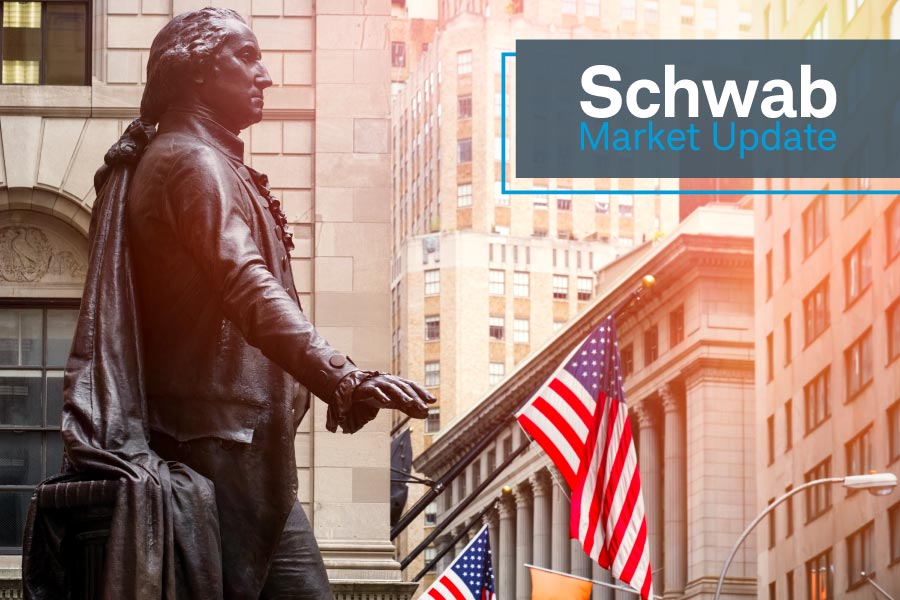Stocks Flat in Tepid Post-Holiday Trading

Published as of: December 26, 2025, 9:06 a.m. ET
Listen to this article
Listen here or subscribe for free to the Schwab Market Update in your favorite podcast app.
| The markets | Last price | Change | % change |
|---|---|---|---|
| S&P 500® index | 6,932.05 | +22.26 | +0.32% |
| Dow Jones Industrial Average® | 48,731.16 | +288.75 | +0.60% |
| Nasdaq Composite® | 23,613.31 | +51.46 | +0.22% |
| 10-year Treasury yield | 4.12% | -0.02 | -- |
| U.S. Dollar Index | 97.87 |
-0.10 |
-0.11% |
| Cboe Volatility Index® | 14.08 | +0.61 | +4.53% |
| WTI Crude Oil | $58.37 | +$0.02 | +0.03% |
| Bitcoin | $89,475 | +$1,725 |
+1.97% |
(Editor's note: Due to light holiday trading, today's Schwab Market Update is an abbreviated version.)
(Friday market open) Major indexes barely moved to start this "bridge" session between Christmas and the weekend. All sport 1% or better weekly gains, and gold and other metals climbed this morning while Treasury yields flatlined. Asian indices ended mixed, and U.K., Australian, and Canadian markets are closed.
Volume could be light today with scant earnings and economic data to provide catalysts, so anyone actively trading might want to use extra caution. Low volume can mean sharper market moves. While Wall Street's run to record highs Wednesday to start the traditional "Santa Claus rally" period put things on firm footing, thin holiday trading could suggest lack of conviction. This sparse stretch is likely to last through next week, meaning participants could be skeptical of current strength and the market might have to "prove itself" when full volume returns.
On Wednesday, stocks rose in a quiet, holiday-shortened session, with the S&P 500 index notching another record high. Nike (NKE) led the way, gaining more than 4% on news that Apple (AAPL) CEO Tim Cook, a Nike board member, bought nearly $3 million in Nike shares. Bond yields slipped, silver hit another record high, and gold was little changed. Though today's economic calendar is light, there are geopolitical rumblings as China imposed sanctions on U.S. defense firms after President Trump's decision to sell weapons to Taiwan, Reuters reported. Next week looks slow from a data and earnings perspective, with the exception of late Tuesday when participants pore over Federal Reserve meeting minutes for clues behind the December rate cut and economic projections.
To get the Schwab Market Update in your inbox every morning, subscribe on Schwab.com.
Three things to watch
- Solid spending, sour attitude: How long can consumers keep opening their wallets even as sentiment measures stay near historic lows? The labor market may tell the story. Though it's been weakening for months, prompting the Federal Reserve to cut rates, it's been low-hire, low-fire—meaning it hasn't turned broadly painful yet. "However, if the labor market continues to soften at the margin, inflation stays sticky, and affordability doesn't improve, consumption might look less robust in 2026 compared to 2025," Liz Ann Sonders, chief investment strategist, and Kevin Gordon, head of macro research and strategy, Schwab Center for Financial Research, said in their 2026 U.S. stocks and economic outlook. Initial jobless claims Wednesday fell for a second straight week, which is what you'd expect to see amid low layoffs. In coming weeks, December's nonfarm payrolls report, job openings data, and retail sales all could provide clues to which way the labor market is headed. But all that comes after the new year.
- A closer look at 3Q GDP: While surprisingly robust consumer spending helped power surging third-quarter economic growth, a closer look reveals that consumers aren't exactly splashing out. The top contributor to the rise in services spending was health care, which accounted for 0.76 percentage points of the 4.3% rise in GDP. That was driven by a rise in spending on outpatient, hospital, and nursing home services. But the government and insurance companies account for the bulk of that spending, and any actual spending by consumers on such services may not be discretionary, much less a sign of bullish economic vibes. Health care's contribution to spending may help explain the disconnect between the rise in consumer spending during the quarter and the recent poor readings of consumer sentiment, which has fallen for five straight months, the longest streak since 2008.
- A rough end to a big year for bitcoin: Bitcoin investors had a lot to be thankful for this year. Growing legitimacy among institutional investors, a pro-crypto U.S. administration and major legislation, and all-time highs. But the last quarter hasn't gone so well. A major crypto liquidation event in October rattled investors, and bitcoin futures prices are down around 24% since then, putting it about 7% lower on the year. Meanwhile, gold and silver have soared since that crypto liquidation in October, with their futures prices rising about 13% and 51%, respectively. The metals' moves call into question a core element of bitcoin's investment thesis: that it's a store of value, the new "digital gold." With bitcoin's price currently limping along in a narrow range, investors may find out relatively soon whether the early days and weeks of 2026 will bring more pain or a revival of bullish sentiment.
On the move
Shares of Micron (MU) and Sandisk (SNDK) continued their winning streaks Wednesday, rising 3.8% and 2.1%, respectively, amid investor optimism about improving conditions in the digital memory and storage market. Both companies posted solid earnings in November but have mostly been buoyed by strong demand for their products from AI data centers and infrastructure. Micron climbed another 2% early Friday and Sandisk was almost 4% higher pre-market.
Intel (INTC) sank as much as 3.3% Wednesday before recovering after Reuters reported that Nvidia (NVDA) recently stopped testing AI chips using Intel's 18A production process. The proprietary production process is meant to challenge Taiwan Semiconductor Manufacturing's (TSM) dominance in the advanced semiconductor fabrication market. Nvidia's decision, if confirmed, would represent a setback for Intel. Intel stock had surged in recent months after Nvidia agreed to invest $5 billion in the company in September following the U.S. government's decision to take a 10% stake.
Chip and AI-related stocks generally advanced in early morning hours Friday. Some of the gainers included Marvell Technology (MRVL), Nvidia, Broadcom (AVGO), and Advanced Micro Devices (AMD), all up 0.5% or more ahead of the open. AMD got a boost from news reports that Chinese tech firm Alibaba (BABA) plans to purchase its chips.
Nvidia's early strength came on news it's entered an inference technology licensing agreement with AI chip start-up Groq that it says will "accelerate AI inference at (a) global scale." As part of the agreement, Groq will remain independent but its team will join Nvidia to help advance and scale the licensed technology. The agreement is valued at $20 billion.
Warner Brothers (WBD) dropped 1.6% ahead of Friday's open after the New York Post reported that the company wants Paramount (PSKY) to increase its hostile offer.
From a sector perspective, Wednesday saw a slight shift from the recent trend, with defensive sectors, including consumer staples and health care, rebounding after a bout of underperformance. Real estate also bounced back after Tuesday's strong third-quarter GDP report reduced rate cut expectations, leading some investors to move away from the sector. Meanwhile, a few cyclical sectors—such as energy and communication services—lagged the broader market.
Overall, Wednesday's broad, yet relatively muted rally contributed to another rise in market breadth for the S&P 500 index. The percentage of S&P 500 stocks trading above their 50-day moving average rose to 61.5%. In late November, that figure was as low as 30%.
More insights from Schwab

A Roth review: While the tax benefits of a Roth IRA are generous, there are specific limitations to consider. Read Schwab's guide to four things to keep in mind about Roth IRAs.
The week ahead
Check out the investors' calendar for a summary of the top economic events and earnings reports on tap this week.
December 29: Pending U.S. home sales.
December 30: FOMC minutes.
December 31: EIA crude oil inventories.
January 1: No major earnings or data expected. New Year holiday.
January 2: November construction spending.